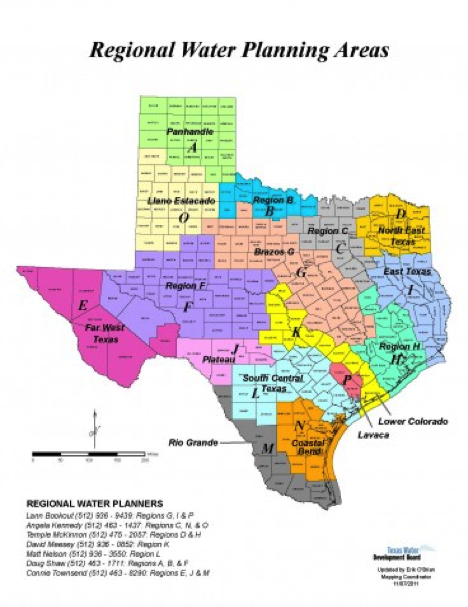
By Jennifer Walker, Water Resources Coordinator
Sierra Club staff and volunteers have been involved in the development of Regional Water Plans in Texas since our state’s “bottom up” water planning process was created in 1997. Texas has been divided into 16 water-planning regions, and each of the 16 regional water-planning groups develops a long-term water plan for its respective area. These regional water plans are submitted to the Texas Water Development Board, which combines the regional plans into a State Water Plan. The goal of these plans is to meet the water needs for Texas for the next 50 years.
Plans are updated every five years and each region will submit their “updated” plan to the Water Development Board by December 1, 2015. In the next several months, the planning groups will consider comments that have been submitted from the public, state agencies, and Sierra Club members. The planners will consider how to address the input before final plans are submitted.
The Sierra Club’s Lone Star Chapter and National Wildlife Federation (NWF) submitted comments on the regional water plans for Region C (Dallas/Fort Worth Metroplex), Region H (Greater Houston region), Region K (Austin and Lower Colorado River), and Region L (San Antonio region and Guadalupe River Basin). You can find specific information about these plans, general information about the regional water planning process, and copies of the formal comments that were submitted on the Texas Living Waters Project website (www.texaslivingwaters.org). The Living Waters Project is a collaboration of the Lone Star Chapter, NWF, and regional partner Galveston Bay Foundation.
Thank you to the Sierra Club members and supporters who responded to action alerts and submitted comments on your region’s water plan. Sierra Club members generated hundreds of comments on each of these plans. Your input about your water supply is important.
Each regional plan is unique, but some issues were consistent among the plans:
- The regional water plans do not recommend strategies to meet the water needs of fish and wildlife. This is a flaw in the planning approach by the Water Development Board that guides how the regional water plans are prepared. To be comprehensive, a water plan should include all water needs and do what it can to ensure that water is available to meet the needs of fish and wildlife. If Texas’ creeks and tributaries, bays and estuaries are not healthy and productive, our communities will not be healthy and productive.
- The regional plans include a variety of proposed water infrastructure projects that would produce a volume of water far in excess of the region’s overall needs (water shortages) during the 50-year planning horizon (2020-2070). This could lead to “overbuilding” and unnecessary environmental, financial, and social costs. Moreover, the need to pay for such infrastructure would likely bring pressure on water utilities to maintain revenue from water sales – creating a disincentive for water conservation. The regional water plans should avoid such situations and only include projects that are needed to meet water shortages identified through the planning process.
- Water conservation and drought management are included in the regional plans to varying degrees. Some regions did a good job of including meaningful recommendations to reduce water use through efficiency and proactive drought response, but more can be done in several regions. Indeed, water utilities in many regions have not implemented the water conservation strategies recommended in their respective regional water plans. With a growing population and intense droughts, Texans need to place a priority on conservation. Water conservation is generally the most cost effective way to address water demands – conservation measures stretch existing water supplies and thus help preserve water for other vital uses such as fish and wildlife habitat preservation.
For more information or for advice on how to get involved in your region’s water planning process, contact Jennifer Walker at jennifer.walker@sierraclub.org.